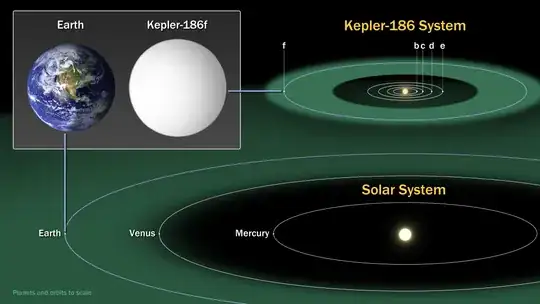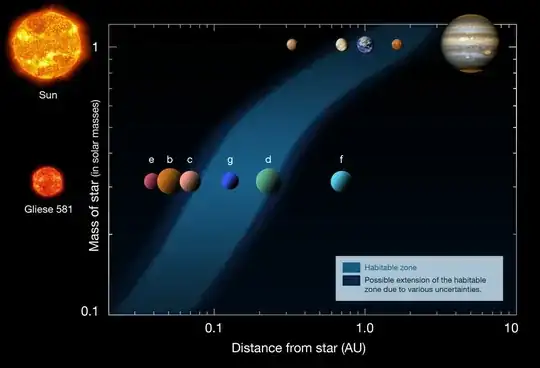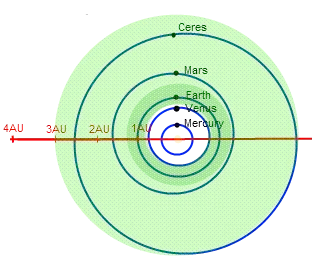It depends on the size of the habitable zone.
Whether or not a planet's orbit is within the (circumstellar) habitable zone (aka the Goldilocks zone) depends on a wide variety of factors determined primarily by the star. Here's the Solar System's habitable zone compared to the habitable zone around the star Kepler-186:

Image courtesy of Wikipedia user Bhpsngum under the Creative Commons Attribution-Share Alike 4.0 International license.
Here are some of the factors that determine whether or not a planet is habitable:
- Luminosity of the star
- Eccentricity of the planet's orbit (highly eccentric orbits, such as the one displayed here, may venture outside the star's habitable zone)
- Temperature of the planet (yes, the planet's characteristics impact habitability)
- Distance from the star (well, of course)
- Whether or not other objects exist nearby which may destabilize the planet
These are really just factors that impact habitability of a planet, but they show that just being in the habitable zone isn't enough. If your planet's atmosphere is such that it's too hot (like Venus), you're in trouble. If the orbit isn't stable because of other objects, or there is lots of debris in the area (e.g. asteroids), you're also in trouble. However, stellar luminosity is probably the biggest factor.
In general, the habitable zones of stars follow the pattern shown here:

Image courtesy of Wikipedia user Henrykus under the Creative Commons Attribution-Share Alike 3.0 International license.
However, there's a lot of error. We're not too sure of how far our own habitable zone extends, as can be seen here.
So it depends on a lot of factors. Next, I'll discuss our habitable zone.
Our habitable zone looks like this:

Image courtesy of Wikipedia user EvenGreenerFish under the Creative Commons Attribution-Share Alike 3.0 International license.
The dark green part is the range of conservative estimates; the light part is the range of liberal estimates. Look at the difference!
I'll deal with the more liberal estimates, because they lead to more interesting scenarios. These mean that Earth, Mars, Ceres (a dwarf planet/asteroid) and the asteroid belt may all be inside it. Most models include Venus as well, as you can see in the second graphic in this answer. So three major bodies (Venus through Mars) and a dwarf planet can easily co-exist.
Scale them down a little, and things are looking good. Venus is about the same size as Earth, and Mars is half as big. Ceres, though, is much smaller. However, I'm willing to bet that scaling it up wouldn't impact the others, although its proximity to the asteroids in the asteroid belt is worrisome. But for now, let's leave it in.
So we can comfortably fit in four bodies. What about five? Well, if you move Mars in a bit, perhaps you could squeeze in a fifth. After that, though, things get dicey. You need to further decrease the distance between the planets. Six would probably be fine; seven is a stretch. Why? Because you have to account for orbital evolution. It's nearly impossible for eight (don't forget about Mercury!) terrestrial planets to form so close to one another, because the early chaos of the Solar System surely would have thrown some of their orbits out of whack. However, this Type IV or V civilization can easily do that. The trouble lies in maintaining long-term orbital stability, although perhaps they could adjust that. Still, perhaps you could put seven in the habitable zone, even if you let them be for a while.
One last thing. As I'm typing this, Oldcat mentioned in a comment something I had planned to get to:
I'm not sure any planet that size can hold an atmosphere in the habitable zone. Mars is .4g and it has its problems.
I don't know about Mars' problems with holding an atmosphere (although that by no means means that they don't exist). Wikipedia claims that the lack of a magnetosphere means that the solar wind can play an issue; whether or not that's true is up for debate, unless anyone reading this wants to go to Mars. Anyway, there is at least one example that shows that even a moon can hold an atmosphere: Titan, a moon of Saturn.
Titan is really large - larger than Mercury, although not nearly as massive. Its atmosphere is more massive than that of Earth, although it's clearly not the same! So small bodies clearly can hold atmospheres. Admittedly, Titan is farther from the Sun than anything in the habitable zone, so it may not be subjected to strong solar effects. But it's something. I don't think it's likely that these small planets can hold atmospheres, but it's certainly possible.
As for how many bodies could share an orbit - well, that's a bit complicated. I've been able to find a question on Physics that talks about it, and it doesn't seem as if even two planets could share the same orbit. Here's something from Carson Myer's answer:
I don't think the situation you mentioned is possible. You're describing two planets, each of which being in each others L3 points (a lagrangian point is a point in an orbit with special gravitational properties, where an object will remain somewhat stationary relative to the body whose orbit it's in). Even our comparatively tiny spacecraft which sit in Earth's L1 point (between the Earth and Sun) require periodic corrections.
Planetary orbits are somewhat unstable: they change by little bits over time, as the sun loses mass and as other planets and solar-system junk push and pull on the planets. If one of these planets' orbit changed just a tiny bit it would fall out of the lagrange point and into another orbit. The planets would begin moving at different speeds and would either collide or move into independent orbits in an astronomically short period of time.
So it doesn't look like four small planets could share the same orbit.


